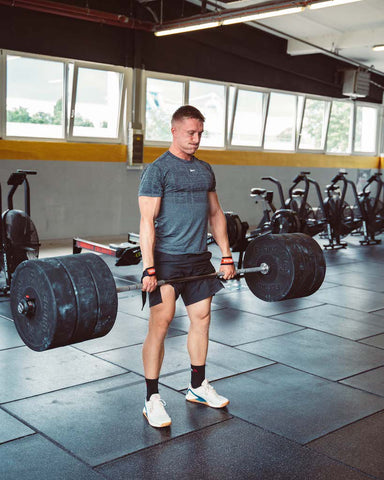Weightlifting Belt- What for anyway?
To give you a quick understanding of the belt, let's first look at the form and function of the whole. The belt is wide, made of either leather or mesh fabric. The material also affects the level of support to a small extent, which is transferred to you from the weightlifting belt itself. It is (in many cases) carried relatively high, so it wraps itself around your stomach region and ends under the ribs. In this way, it keeps a firm grip on your core and forms a kind of armor layer that you can rely on when the going gets tough.

Corset in small:
The weightlifting belt, even if it has long been part of the iron inventory in sports such as functional fitness, powerlifting or Olympic weightlifting, is due to something else: the corset or corset has been known for much longer in human history, but follows similar ones Purposes: A weight lifting belt is similar in thought to a passive corset. This stabilizes the pelvic region and the torso is held in place by the lashed belt section. What follows in the case of sport is more stability, more power in the lift with good control and a better erection while you're on the barbell.

When to use a weight lifting belt for the first time
Now we turn to the question of all questions: compression, increase intra-abdominal tension, increase strength with help. That's all well and good. But when should you start using belts like the ones from Picsil in our shop?
Important to know:
One thing in advance: We don't want to introduce you to aids too early. Support muscles are important, not only in sports, but also in everyday life. After all, we don't just do sports to look good, but that fitness also becomes part of life. So one thing counts first: execution, execution, execution! Basic exercises and auxiliary movements help you to position yourself more broadly in WOD. Squats or deadlifts, which are actually predestined for a weight-lifting belt, also make sense with a light weight and free execution to start with sports at all.

But at some point it will be enough
However, if you stagnate in your training plan and get stuck for a while, have mastered the basic exercises and honed your technique, then it's time for an upgrade with belts like the one from PicSil. It cannot replace muscles, but it can provide more tension and endurance. Overall, you move more weight or set more stimuli. This aspect is also broken down into the basics of muscle building: Strength of the stimulus times the length of the stimulus. So if you find out on a belt test that you can either lift more weight with the same number of reps or break off more reps with the same weight: just go for it! You know your body best. Listen to him, don't overload him, but also don't fall short of your potential when you can do better with a simple tool like weight lifting belts.Pro tip: Differences in weightlifting belt positioning
Does the belt always have to be around the abdomen? You may be asking yourself this question of conscience after reading this blog text, but here too we can reassure you: No, absolutely not! While doing compound exercises like squats and deadlifts, it makes far more sense to keep the core stable to prevent evasive movements. But in other areas of fitness, the weight lifting belt has to sit differently for the desired success. In the long cycle of kettlebell sport, the strip of the belt is almost attached to the hip. Why? Because you lean back slightly in the push motion and when catching the kettlebells. This puts more strain on the lower lumbar vertebrae, but the belt is also used as an aid to rest the elbows. If you press your elbows tightly to the lower center of your body in the rack position, you save energy. This way you get more repetitions from your round. Once the kettlebells rush out of your hand, your round is over. So always remember: goal-oriented training also means attaching the weight-lifting belt in a goal-oriented manner.
how about you Do you use weight lifting belts like the one from PicSil and if so; Do you belong more to Team Leather or Team Mesh? Write us a comment about it!









